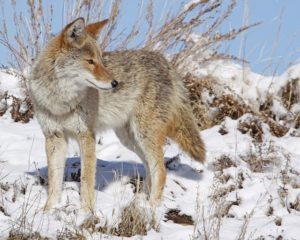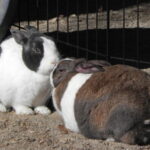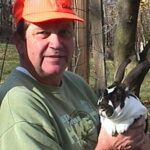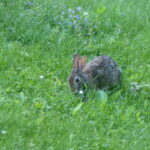by Marion Patterson | Apr 3, 2025 | Mammals
An odd shed deer antler caught our eyes during a woodsy March walk. We’ve enjoyed shed hunting for years and have found plenty, but this one was unusual.
What is a Shed?
Deer, elk, moose, and caribou all shed their antlers a couple of months after the breeding season. Usually in January and February the antlers loosen from the bucks’ heads and fall off. We’ve learned to seek sheds in places where a deer jumps over a fence or crosses a stream in a deep valley. The jar caused by the jump or climb sometimes dislodges the antlers. Sometimes just one drops and the other at some other place. Other times, one can find a matching pair of sheds. Gold!
Oddity

Odd find.
The antler we found recently wasn’t especially large, but its location was weird. It was four feet off the ground in the branches of a tall shrub. We guess that the buck was walking through thick shrubbery when his nearly ready to fall off antler caught in the branches and came off. That’s unusual but there was one other strange thing about it.
Location and Condition
We walk that trail often but never noticed the antler on earlier walks. It was well-weathered and bleached white. A squirrel had chewed a big notch out of the antler, almost cutting it in two. So, it must have come off the deer about a year before we found it. Why we hadn’t spotted it sooner is a mystery.
Why Shed Hunt?
Antler hunting is a fun outdoor activity. They can be found any month, but the best season for searching is in late winter, just after the deer have shed them, the show has melted, and before spring vegetation grows to hide them.
Matter of Luck
We’ve noticed another odd thing about shed hunting. At least for us. When we go out deliberately seeking them, we sometimes, but rarely, find one. At other times when we’re absent-mindedly rambling through the woods we’ll step on one!
In An Improbable Place

Golden! A pair.
The deer that caught his antler in the shrub likely lived to shed a new set of antlers this year. Maybe our neighbor found it. She was astonished to find two shed antlers on the lawn behind her house, only about 500 yards from where we found the seasoned and chewed one. The new finds were much bigger, but bucks generally grow a larger antler every year.
Keep your eyes open for these fun finds.
by Winding Pathways | Feb 20, 2025 | Mammals

Night activity
Coyotes have moved into town. They’re showing well within huge cities and towns from the Atlantic to the Pacific. Sometimes early news reports of urban coyotes bring concern among residents. Are they dangerous? If you listen to media or follow social media then you might reach one conclusion. And, if you use logic you come to a more reasonable conclusion.
Long Relationship With Coyotes

Coyotes are secretive creatures.
Our relationship with coyotes goes back decades. In the fall of 1971 Rich worked for a farm chemical company in Idaho, delivering fertilizer to wheat farms. One day after he and a farmer unloaded the truck, they sat on the tailgate eating lunch. Across the harvested wheat field, a coyote emerged from the woods and pranced along the field’s edge. Although he was far away, we saw him successfully catch a tiny animal, probably a mouse.
The farmer said, “There goes my best employee. That coyote works night and day catching mice that eat my crops. He never complains, doesn’t expect a paycheck, and completely takes care of himself.”
Coyote Expansion
Back then coyotes mostly lived in rural areas from the Midwest to the Pacific Ocean and north to the Arctic. They never abandoned their rural roots, but over the years enterprising coyotes moved into towns and cities and expanded their range to the Atlantic. Now they’re common across nearly all of North America. Although rarely spotted, coyotes have moved into town.
Adaptable Coyotes
Coyotes are amazingly cunning and adaptable animals. Their much larger cousins, timber wolves, were trapped and shot to extirpation in most areas. Despite centuries of human persecution, coyotes kept expanding. Unlike wolves, they learned to adapt to living in close proximity to humans.
Local Coyotes
 For many years a coyote pair maintained a den and raised litters of pups in a den about 300 yards from our house. We don’t see them often but spot their tracks crossing our lawn after a new snow. Every once in a while, a distant ambulance or police siren warns motorists to pull over. Often “our” coyotes respond by singing just after the siren stops. Sometimes they yip and yap with no obvious triggering sound. We love hearing them. YouTube has many videos of coyotes howling.
For many years a coyote pair maintained a den and raised litters of pups in a den about 300 yards from our house. We don’t see them often but spot their tracks crossing our lawn after a new snow. Every once in a while, a distant ambulance or police siren warns motorists to pull over. Often “our” coyotes respond by singing just after the siren stops. Sometimes they yip and yap with no obvious triggering sound. We love hearing them. YouTube has many videos of coyotes howling.
Diet

Tell tale sign of coyotes
Although a coyote’s favorite meal is a mouse, cottontail, or other small mammal, they enjoy a varied diet that can include fruit, dead roadside animals, discarded pizza slices in an urban alley, and a host of other goodies.
Are Coyotes Dangerous to People?
Everything’s relative. Since 340 million Americans live close to coyotes it’s amazing how few incidents occur. They do happen, with the highest number of coyote bites happening in California. For detail check out publications at Urban Coyote Research Project.
Contrast that with deaths caused by dogs. Their bites cause an average of 43 human fatalities a year.
Are They Beneficial
They sure are. Drive through suburbia on a June evening and odds are that juvenile cottontail rabbits are hopping on lawns, in gardens, and across roads. Do the same drive in the fall and only an occasional bunny may be sighted. If left unchecked both rural and urban areas would be overrun with mice, rabbits, voles, and rats. Thank coyotes and owls, hawks, and foxes for keeping prey numbers at a low enough level to make gardening possible,
How In the World is “Coyote” pronounced
We prefer the Idaho pronunciation “coyOTE” with two syllables. Others say coyoTEE with three syllables. Take your pick.
Back to the story of the farmer. After he spotted the coyote stalking mice in his field he yelled out, “Thanks, fella. Keep up the good work!” Anyone might say the same when they spot a coyote anywhere……but be cautious. Never approach one closely, particularly if it seems ill or injured. Keep a distance away. Usually, it will slink off as soon as it spots a person.
by Winding Pathways | Feb 13, 2025 | Mammals, Nature
Beavers moved into town. Even a large city like Cedar Rapids.
Surprise
An amazing sight greeted us In December 2024, as we walked a circular trail around a tiny unnamed stream in the heart of Cedar Rapids, Iowa. A beaver dam spanned the narrow waterway. Beaver-felled trees lined the bank while bark-peeled branches floated in the still water.
Nearby were two busy roads, houses, and apartment buildings. Tall downtown buildings were just a mile away. So were factories. These beavers are urban.
-

-
Cedar Lake, Cedar Rapids, Iowa.
-

-
A beaver chew next to urban stream.
Urban Beavers
Beavers in a city of 140,000 people! 100 years ago, no one would have imagined that beavers moved into town. But today North America’s largest rodent has moved into cities across the continent. They thrive despite noise and human activity.
Watching City Beavers

Chewiing
Lots of people enjoy urban birding, and beaver-watching is just as fun. Their territory is easy to find. Fetch a lawn chair, dress warmly, bring binoculars, and perch within sight of beaver activity in the early morning or late afternoon when they’re likely most active.
What to Look For
No animal leaves such visible and durable calling cards as does a beaver family. We walk trails along rivers and often spot trees felled by the sharp teeth and powerful jaw muscles of ambitious beavers. They relish eating the thin nutritious bark covering branches. Beavers leave so much debris around it’s hard to miss finding an active colony.
-

-
chips
-

-
Beavers slide
While waiting for beavers to appear keep your eyes peeled. Beavers are a keystone species that alters its environment by cutting trees, digging den holes in the bank, and backing up streams. Their activity attracts many other species, including muskrats, mink, and a host of songbirds that frequent the water’s edge.
An Amazing Resurgence Follows Sad Exploitation
When early Europeans crossed the Atlantic, they found a beaver-filled continent. Experts guess there were somewhere between 60 million and 400 million of the furry animals from coast to coast. That soon changed. European beavers had been hunted and trapped for ages and weren’t common, so newly arrived Americans almost immediately began trapping the huge rodents.
Legendary mountain men combed the Rockies to find plentiful beavers and hundreds of thousands of pelts were shipped eastward in canoes by Canadian voyageurs. Many were shipped to Europe. In the days before synthetic insulation fur kept people warm, and fashionable beaver hats were made from their hair.
Decline and Ethics
The fur trade lasted about 250 years until the late 1800s when the animals had been extirpated from vast parts of their original range. Then came happier news. The value of beaver pelts sank as hats went out of fashion, trees rebounded along streams, and new conservation laws and ethics arose. That started a slow comeback, and now beavers seem to be everywhere.
Two Species
There are two beaver species – the North American and Eurasian. Both are similar but the Old-World species is slightly larger. Each species has made a dramatic comeback. American beavers were released in Finland and Patagonia, where they now thrive as invasive species.
Where Are the Beaver Dams?
Children love reading books about beavers and know that they build dams. Well, not always. These ambitious animals are smart. If their pond, lake, or river is deep enough there’s no need to build a dam. They simply tunnel into the bank to create a home or, sometimes, build a dome-shaped house of sticks and mud that’s usually easy to spot.

Crossing a small stream.
However, if their stream is narrow and shallow beavers spend nights changing it. They’ll build an amazingly sturdy and often long dam spanning the stream, creating water deep enough for good swimming and hiding a bank tunnel entrance below the surface. Beavers are engineers.
Easy to Watch Urban Beavers
Years ago, beavers were hard to find, even in rural areas. Not anymore. They’re so common in urban areas that people can enjoy them without making a long drive.
by Winding Pathways | Nov 21, 2024 | (Sub)Urban Homesteading, Mammals, Nature
Flying squirrels are phantoms of the darkness. Are they nearly invisible waifs, ghosts, or fascinating and beautiful mammals? Fortunately, they are real, moderately common in good habitats, but hardly ever seen by people.
Marion recalls her Uncle Bill taking her outside one evening in Florida. Quietly they waited at dusk and suddenly, a petit squirrel launched from a tree and glided past. A thrilling sighting for a seven-year-old and a fond memory all these years later.
For many years a colony of southern flying squirrels lived in a massive hollow elm at the Indian Creek Nature Center. Although their tree was next to a busy trail, daytime hikers never saw the animals. Many times, I’d lead people to the tree as darkness gathered. We’d sit quietly. Just as it became almost, but not quite, so dark that vision was impossible squirrels would appear from a hole in the tree. We couldn’t really see them glide but could hear a rustle of leaves as one landed nearby. Flying squirrels are delightful.
Two Species
Many people live close to them and don’t realize it because they are so nocturnal. Two species live in North America. The northern flying squirrel lives mostly in Canada, and the southern one lives from about the Canadian line south to the Gulf of Mexico, so most people live in their range.
Can They Really Fly?
Flying squirrels are tiny but can’t fly. They are gliders and probably should be called gliding squirrels. A special adaptation, called a patagium, allows them to extend loose skin along their sides to form a sort of wing. This allows them to glide from up in a tall tree to the ground or the lower section of a tree trunk.
They live in woodsy areas with big nut trees, especially oaks and hickories with plenty of fallen trees on the ground. They live in hollow trees. Come late evening they scurry about seeking seeds, mushrooms, bird eggs, and insects to eat. They are omnivores. Their greatest enemy is the Great Horned Owl, also nocturnal.
Conflicting Schedules
It’s ironic that just as people head indoors as darkness descends, flying squirrels emerge so they are rarely seen. Here’s a trick to help people spot the elusive animals.
Flying squirrels love birdseed. They’ll visit a feeder after dark. So will raccoons, opossums, deer, bears, and mice. A feeder can be as busy at midnight as noon.
How You Can Enjoy Sightings of Flying Squirrels
To enjoy flying squirrels and other nocturnal visitors shine a flashlight on the feeder every once in a while, after sunset. With luck, there will be flying squirrels snacking on seeds.
Although many people let bird feeders be empty overnight, we do the opposite and scatter seed on a platform feeder and the ground. It’s a surefire way to attract the night shift.
Photos Are Hard To Come By
We don’t have a photo of flying squirrels because we’re never near the feeder ready to take pictures in the darkness when the squirrels visit. The National Wildlife Federation offers excellent information about flying squirrels. And YouTube has some fun videos to watch on them.
We also enjoy diurnal squirrels that frequent Iowa yards and forests.
by Winding Pathways | Sep 5, 2024 | (Sub)Urban Homesteading, Foraging, Mammals
A few years ago, after seeing many squirrels with nearly naked tails we researched and posted a blog in February 2022. Furless Tailed Squirrels.
The response amazed us. People from around the world visited it and still do every day. We had no idea this condition was so widespread.
So, we’re posting a follow-up. Two winters have passed and our squirrels now have perfectly normal furry tails. We’re unsure if older squirrels have regrown fur or if the new generation never had the condition. Since most squirrels don’t live for more than a few years, we will likely see younger animals.
Whatever conditions caused them to lose their fur seem over. That’s not unusual in wildlife populations. If a serious disease or calamity reduces the population the condition subsides and survivors reproduce with enthusiasm, rapidly restoring abundance.
Based on our website traffic we suspect furless-tailed squirrels have been found far and wide. We predict that they, like our Iowa squirrels, will rebound with healthy furry-tailed animals.
A Short Squirrel Primer
Although many people dislike squirrels for their habit of gobbling up feed intended for birds, we like them. Squirrels are just as fascinating as goldfinches or cardinals, so we put out enough seed for both.
During the 2024 Summer Olympics, we were thrilled watching the graceful and powerful movements of Simone Biles, other gymnasts, and pole vaulters like, Armand “Mondo” Duplantis.

What happens when a squirrel falls?
We’ve not heard of a comparable competition for squirrels, but they are also amazing gymnasts and vaulters. In our yard a small oak and a large walnut live next to each other. Every fall the walnut is loaded with nuts that tempt squirrels. We love watching them climb the oak to its tippy top and then make an amazing upward leap to a flimsy walnut twig above. Like human gymnasts and vaulters, squirrels have impeccable balance, flexibility, strength, determination, and courage.
Treetop leaps aren’t always successful. Twice we’ve seen squirrels slip off high oak branches and fall 30 or 40 feet to the lawn below. Both times the hapless animals spread eagle, landed with a thump, and scampered off apparently uninjured. They are an amazing animal.
Late Summer Activity
As we write this in late summer walnuts and acorns are maturing. People may not like squirrels but these trees need them so much their annual nut crop is a bribe. Squirrels eagerly gather and eat many of the nuts but they scamper off and bury some, often a long way from the parent tree. Some nuts are never dug up and become a new tree generation. The exchange is a good deal for both trees and squirrels.
The rodents get nutritious food. Walnuts and acorns get free tree planting. Both win.
Hopefully, anyone reading this is enjoying squirrels that have grown fur on their once furless tails. Enjoy these amazing animals. To learn more about squirrels visit Animal Diversity.
by Marion Patterson | Aug 1, 2024 | Garden/Yard, Mammals, Pests

Young rabbits “play” to gain skills and show dominance.
Have you noticed the abundance of the cottontail rabbit this summer? While they can create mischief as in eating desired plants, they also are fun to watch.
Winding Pathway’s resident cottontail rabbits give us delightful evening entertainment. Shortly after sunset, a few appear like magic from out of our labyrinth’s tall prairie. As we sit on our porch they scamper about, chase each other, and nibble on the white clover poking out of our lawn.
Many people dislike cottontails for their habit of feasting on favored garden plants and gnawing on tree bark in the winter. Because we enjoy both rabbits and Swiss Chard, we keep them away from our vegetables and, thus, appreciate their antics.
Several cottontail species range across most of the United States, southern Canada, and South America. They’re well adapted to thrive in diverse environments. Ours is the Eastern Cottontail rabbit. This year they are especially abundant.
There are Rabbits and Then There are Rabbits

Side by side
Cottontails and common domestic pet rabbits may look similar but they are vastly different.
Pet Bunnies
Pet bunnies trace their ancestry to Europe and were domesticated thousands of years ago. They make fascinating and loveable pets and thrive in a safe roomy hutch eating commercial pellets. These are the rabbits that were released in Australia and caused enormous agricultural and ecological damage. They readily breed, are social, and join others to dig a series of burrows called warrens. Some readers may remember the award-winning novel, Watership Down, and the Netflix series about precocious rabbits.
-

-
Children and adults enjoy bunnies.
-

-
Rabbits are social.
-

-
Friendly pets
-

-
European rabbits adapt to people
-

-
Show animals.
-

-
Children with rabbits
Cottontail Rabbits
Cottontails, in contrast, are wild animals that rarely, if ever, become tame or make good pets. Like European rabbits they are social and like the company of other bunnies but not people. Cottontails don’t make burrows but sometimes enjoy ducking down an abandoned woodchuck hole. Cottontails live under dense vegetation, in culverts, and under outbuildings. They eat a wide range of wild plants but love snacking on vegetables. In winter they sometimes eat the bark off young trees. So, be sure to protect your young trees with wire mesh around the base.
-

-
Time for an evening snack.
-

-
bunny play
-

-
Nibbling clover
Enjoying Both Cottontails and Vegetables
Years ago, we learned a trick that lets us enjoy our resident cottontails and abundance from the garden. European rabbits are high jumpers, but not cottontails. Instead, native bunnies are long jumpers who can’t jump high. Just a wimpy two-foot-tall chicken wire fence around the garden or a young tree keeps them away as long as they can’t get under it.
-

-
Keep rabbits away from young trees.
-

-
Cottontails cannot jump high.
Why So Many Cottontails This Year
For the past few years, Iowa has been in drought. It limited the new tender growth of clovers and other delectable plants that bunnies love. Sparse rain thinned thickets where they hide. This year’s been wet. Vegetation is tender and abundant yet we’ve not had big early thunderstorms. Why’s that important to a cottontail?
Before giving birth, a cottontail digs a shallow hole in the ground, often near the edge of a lawn. She lines it with fur and soon deposits three to eight tiny blind helpless babies. Mom mostly stays away but nurses them in the morning or evening by sitting over the burrow and letting her babies nurse. They grow amazingly fast and are out on their own when only about three weeks old. Mom soon gets ready for another litter.
Who Doesn’t Love a Cottontail Rabbit?
Predators love rabbits. They’re a favorite meal for dogs, cats, raptors, snakes, foxes, and coyotes. There are always rabbits because their survival strategy is to have many babies, even though only a small percent reach adulthood and reproduce.
Getting Rid of Cottontails
Well, why do it? They are inquisitive and beautiful animals that share yards with people.
An easy solution is to run chicken wire around desirable plants to keep them away. So, people can have their plants and rabbits, too.
Hooray for bunnies! They brighten our evenings as they scamper about our yard.
-

-
Rabbits know to stay hidden
-

-
Cottontails live in the labyrinth.
-

-
Nibbling clover





 For many years a coyote pair maintained a den and raised litters of pups in a den about 300 yards from our house. We don’t see them often but spot their tracks crossing our lawn after a new snow. Every once in a while, a distant ambulance or police siren warns motorists to pull over. Often “our”
For many years a coyote pair maintained a den and raised litters of pups in a den about 300 yards from our house. We don’t see them often but spot their tracks crossing our lawn after a new snow. Every once in a while, a distant ambulance or police siren warns motorists to pull over. Often “our” 





















